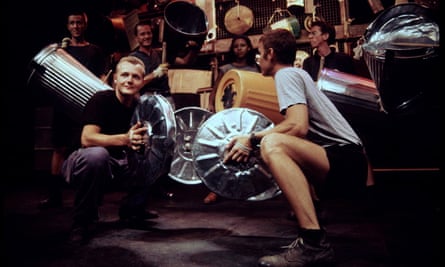Luke Cresswell, co-creator
In the 80s I was a street performer in a band called Pookiesnackenburger with Steve McNicholas. I was the drummer, and rather than carry kits around I started getting into playing objects and experimenting with visual ideas. I had an act called the Urban Warriors where we would drum wearing suits of armour. I started doing lots of stunt performances, such as being suspended off the pier in Brighton or hanging off a ship at sea.
I was also doing session drumming – I was in Beats International with Norman Cook – but there was a part of me that really enjoyed performance, creating scenes and movement. We had a pitch busking at Covent Garden in London, and saw the phenomenal Drummers of Burundi there doing a publicity spot. At the end they lifted these drums up and hitched them over their shoulders, so as they walked away they looked like old fashioned dustmen with metal bins on their shoulders. That’s where the idea for the bin number came from. We started to think about the iconic things we have that make a noise. We’re not dancers, but using props allowed us to dance and make visual rhythms.

Lots of crazy things happened. We did a Heineken advert; we got dragged into a TV show called The Mondo Beyondo Show by the New York performance art group the Kipper Kids, which Bette Midler was hosting – she is married to one of them. Stomp was an idea to combine all these acts and rather than just the two of us, have eight people and put it together as a show, a hybrid of music, dance and comedy.
We did a 40-minute version at Brighton fringe, very high energy – we were all terrible smokers, so when we performed the whole thing through we couldn’t breathe. We got the midnight slot at the Edinburgh festival fringe in 1991. We had to go to the top of Arthur’s Seat to rehearse because it was the only place we could bang our dustbins without getting kicked out. We didn’t get a public audience because no one knew who we were, but a lot of the other performers came to watch us after their own shows. The first show was great, it was mad, there was nothing like it at the time. Rhythm is infectious, but people enjoying themselves is also infectious.
Steve McNicholas, co-creator
I was introduced to Luke when he was coming off stage, all sweaty from doing a show at a pub in Brighton. He was 17 and quite a formidable looking young lad with a skinhead. We were a few years apart but found we had complementary interests. He is a drummer, I was originally a violinist, working in theatre. He is rambunctious and I was quiet. Quite often people thought we were brothers; we were just strangely on the same wavelength.
In the early days we would do miners benefits and things like that, Luke put together the brooms piece for a benefit. We were watching a bunch of street cleaners at a big event in Glasgow, 12 of them going down the street and it looked great. That’s where the concept came from. Luke did a thing swinging from the ceiling of a club in Brighton with Cook. We realised all these pieces could fit together. Luke is the percussion master and I have often been the outside eye looking for light and shade, asking how do you make repetitive rhythms into a piece of theatre? And trying to stop it just being a group of self-indulgent drummers.


Comments (…)
Sign in or create your Guardian account to join the discussion